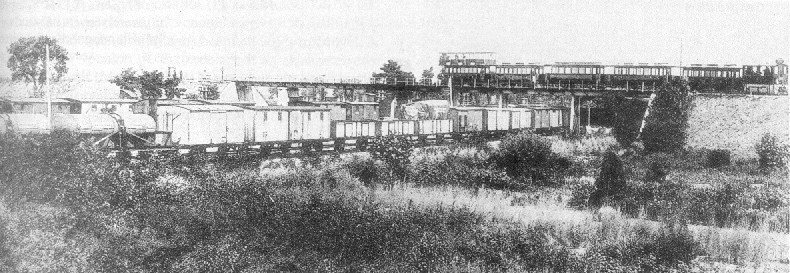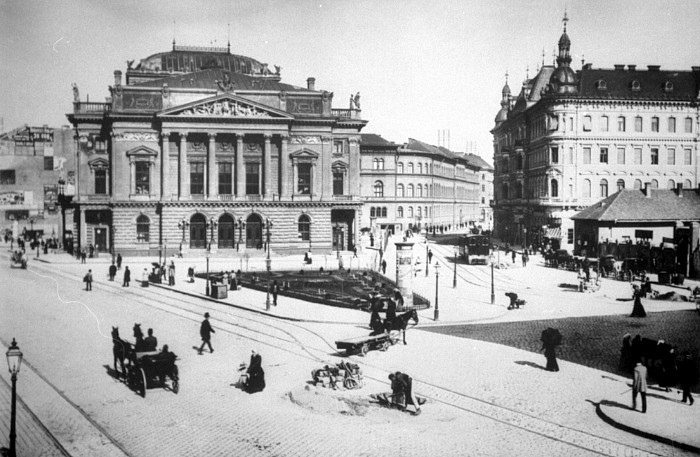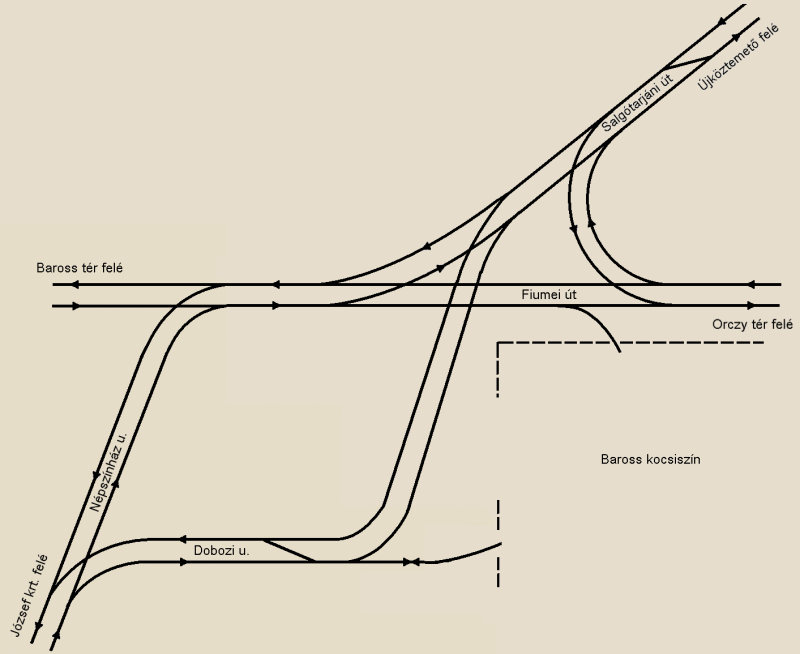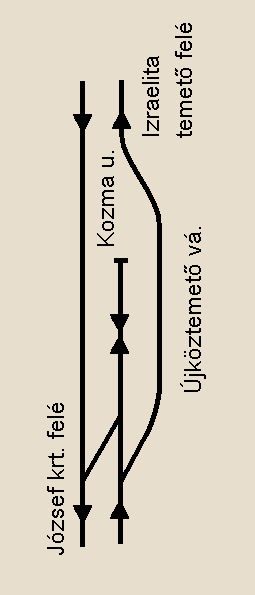Tram-hiker's
guide to Budapest
Latest update: 5. January,
2016
![]()
Route
28, 37/37A and 62
Tram-hiker's
guide to Budapest
Latest update: 5. January,
2016
![]()
Route
28, 37/37A and 62
The "twin" routes 28 and 37 are probably the most archaic tram routes in Budapest - they are remnants of an archetype urban transportation service: one connecting a growing city with a large new cemetery outside the city, built to replace several old ones. In later times these two lines also connected housing areas with industrial areas, but that usage is mostly history now that most factories were closed after the fall of the communist era. What remained are forlorn streets, somewhat resembling other ex-Eastern Bloc industrial cities like Katowice. Oh, and prisons: there are two such facilities near the outer end of line 28 - that's why the line received the nickname "con route" (fegyencjárat) in urban folklore.
I guess this introduction gives you a hint how disreputable these tram lines are - yet, they certainly have a strong appeal on tram enthusiasts. And tram 37 is certainly a must with its varying landscape ranging from ancient cemeteries in the green to post-apocaliptic movie sceneries :)
BVV's New Public Cemetery Line
The tramway service to the New Public Cemetery (Új Köztemető) has an interesting history. Although it was built in 1891, when Budapest has already had multiple electric tram lines, it was opened with steam traction. The traction vehicles were the ones that had had to be purchased as a reserve for the two electric lines of the company BVV (in case electric traction should not work out). This was the only urban steam tramway in Budapest: steam traction was only used by the HÉV (suburban railways) otherwise.

On the photo above, we see a train of the "Public Cemetery Steam-engined Railway" on the flyover bridge at Pongrácz út, with a double-deck car at the end. The railway had a main line to the cemetery, and also a branch-line to Liget tér, which was later extended to Kápolna tér, forming the basis of later days' route 36.

Depicted on this photo is today's Blaha Lujza tér around 1891. The nice building dominating the scenery is the Népszínház (Popular Theater - later National Theater), after which Népszínház utca was named. Steam traction did not last long: the Liget tér line was converted to electric usage in 1893, the cemetery line one year later. The latter's alignment is known today as tram line 37.
Years before BVV came, the company PKVT (later merging into BKVT) launched a horse tram service from Orczy tér to Kőbánya, connecting to its Rákóczi út lines via Fiumei út. It was later electrified, but the level crossing with the state railways at Liget tér made this line inferior (slow and unreliable) for reaching downtown Kőbánya, in contrast to the branch-line of the BVV (later BVVV) via Korponay utca.
The stub Kőbánya tram line was connected to the cemetery line in 1928. Line 28 was originally the one running where today's tram 37 runs, and vice versa. Also, tram 37 only ran to Akna utca for quite a while, but then it was extended to the cemetery, resulting in the quite uneconomic situation, where two full-time tram services were serving a location, which sees extensive traffic only on All Souls Day. This changed in 2005, when the off-peak service 37A was shortened to Sörgyár.
![]()
Route 28: Blaha Lujza tér (Népszínház utca) - Népszínház utca - Teleki László tér - Fiumei tér - Orczy tér - Kőbányai út - Kőrösi Csoma Sándor út - Éles sarok - Jászberényi út - Maglódi út - Sírkert út - Kozma utca - Izraelita temető(10.6 km)
Vehicles: 7 x Tatra
T5C5 plus 2 x TW6000
(on weekends only)
Depot: Baross, Hungária, Száva
Route 37: Blaha Lujza tér (Népszínház utca) - Népszínház utca - Teleki László tér - Dobozi utca - Magdolna utca - Salgótarjáni utca - Pongrác út - Kolozsvári uta - Éles sarok - Jászberényi út - Maglódi út - Sírkert út - Kozma utca - Új Köztemető, Kozma utca (9.3 km)
Vehicles: 8 x TW6000
Depot: Hungária, Száva
37A is the off-peak service of tram 37 - with less vehicles.
Route 37A: Blaha Lujza tér (Népszínház utca) - Népszínház utca - Teleki László tér - Dobozi utca - Magdolna utca - Salgótarjáni utca - Pongrác út - Kolozsvári uta - Éles sarok - Jászberényi út - Sörgyár (5.8 km)
Vehicles: 4 x TW6000
Depot: Száva
![]()
Blaha Lujza tér /Népszínház utca/
In a side street right next to the busy Grand Boulevard routes you will find the terminus for route 28, 37/37A, 62, bus line 99, and also the connection to one of the two corridors used by Grand Boulevard trams for depot rides (the other being Mester utca).
Traffic here can be quite lively, especially when a special ride or transport arrives. On weekday mornings you have high chances to catch something like that, and besides, early morning is IMHO the only time when trams are properly lit by the sun here :)
The track layout is a typical double scissors
crossover - or "suspenders" (hózentróger) as we call them.
After the terminus, the tracks change from the side to the middle of the street.
Tram stops are built in the "inverse bay" manner, with the sidewalk reaching to the tracks. Around mid-afternoon you have a fair chance of getting some sun shining onto the trams, but only at the crossings. By the way, from the size of the crossings you can get a hint that once this was a blooming civic quarter - but after WW2 it became impoverished. The 80s/90s were - hopefully - the bottom point, now it gets better every year. Of course it's still far from being a tourist attraction :)
| Lost
rails: Karácsony Sándor utca
The Karácsonyi Sándor utca-Diószeghy Sámuel utca-Kőris utca line was another BVVV's competition line. This time its goal was to avoid BKVT's tracks in Fiumei út and Orczy út (this time it was BKVT who did not allow the usage of its tracks for the BVVV). It was built in 1913, and closed in 1941. Karácsony Sándor utca near Teleki László tér. Interestingly the tram on the picture has started its life as a passenger car on the steam-hauled cemetery railway. Also interesting is that a number of overhead posts are still in situ (see picture to the right). |
Teleki tér is where one of the city's last few run-down marketplaces is (many of them were renovated or modernised, but not this one). Not my sort of place, I must say.
But of course we're not here to buy food, but to see trams - and after the marketplace, the square evolves into one of the most interesting tramway facilities of the city:

Map drawn by Mr. Balázs
Fejes, later modified by me
Line 37/37A turns right into Doboz utca, encircles a small park, and then turns left into Magdolna utca to reach Salgótarjáni utca. Line 28 runs about hundred meters forwards, and then turns right into Fiumei út. Line 24 arrives from Baross tér (left-hand side on the map), and joins line 28 at the upper left corner of the small park. The bend leading from Fiumei út to Salgótarjáni utca was once used by the exhibition line 29Y, and is sometimes still used by the cemetery line 37B (and by depot/special rides). The bend to the other direction is used by depot rides and transports. On the map we can also see two entrances into the depot ("kocsiszín"): the one on top (from Fiumei út) is not used, while the other one (below, accessable from Dobozi utca) is probably used more often than the depot's main entrance.
-> Jump to route 37/37A in Salgótarjáni utca
-> Jump to route 28 (and 24) heading for Orczy tér
![]()
The standalone section of route 37/37A
This stretch only remained probably because of the rear entrance of the depot. But thanks to that we still have this photogenic bend to take photos of, with hardly any vehicular traffic getting into our pictures :)
After that photogenic bend we cross route 24 and 28 in Fiumei út.
As I mentioned, depot rides and transports are not rare in these bends. I especially like the hour before the afternoon rush-hours start, but with a little patience you can get a good shot at something at any angle of the sun :)
We stroll along the fence of the ancient Kerepes cemetery for the next few hundred meters. The other side of the street (to the right) belongs to the now closed Józsefváros railway station and container terminal.
It's not a really great sight, but still, you can make some interesting pictures here.
After the cemetery, the tracks climb the ramp of the railway flyover bridge near Asztalos Sándor utca.
After the bridge we have the Hidegkuti Nándor stadium from 1912 on one side, and an old railway labourers' housing area on the other (complete with its very own church).
The crossing of Salgótarjáni utca and Hungária körút
As I said, route 37 features interesting track layouts, and this crossing is a nice justification for that statement:
To make the facility even more complicated, the trolleybuses of Budapest also go through here to and from their depot (the only one in the city).
Further along Salgótarjáni utca
After just a few hundred meters, we start to climb upwards, again:
Next to the ramp you'll see the central trolleybus depot. I wanted to insert a photo of it, but then found out I don't have any. On the other hand I have lots of photos of transports on this ramp, like the two shown above. It seems I'm much more into Muki trams then trolleybuses. What a surprise ;)
-> Link to a short description of the trolleybus depot
The railway flyover and the ramp to Őrház
The ramp leads to yet another flyover bridge above state railway tracks.
Interesting to note that the narrow sidewalk on the bridge (left) can be used by pedestrians legally. Of course the bridge looks better from a bit away (right).
| Lost
rails: route 29/29Y to Lóverseny tér/BNV
The BSzKRt launched a branch-line to the nearby racecourse in the 1920s. In the seventies, the Budapest Exhibition Center "Hungexpo" (popularly known as the BNV) also settled here, making frequent use of the periodic tram service 29/29Y. Sadly the service wasn't relaunched anymore after 1996. The most interesting spot on this very short branch was a level crossing with a state railway line electrified at 25kV AC. There was also a connection between the tram and the state railway. As you can see on the photos above, the tracks are still there, but the tram's overhead wires were stolen (!). Here's a map of the rather large terminus facility, drawn by Balázs Fejes |
We now descend on a winding ramp.
The curves are tight and the tracks are worn, so the ride gets slow here.
After passing under another state railway line (yes, there are quite a lot of them around here), we arrive to the place commonly known as "the Blockhouse" (Őrház). The railway post is long gone, just like the junction it was securing:
The name Őrház now belongs to a forlorn-looking transformer station of the BKV.
Railway on one side, houses on the other.
The tram also passes by the railway station Kőbánya felső (Upper Kőbánya), but don't expect hundreds of passengers boarding the tram.
Soon we arrive to Éles sarok, where we join route 28, and also 3 and 62.
-> Continue to a more detailed introduction to Éles sarok
![]()
The standalone section of route 28
After leaving Orczy tér, we arrive to what I call "the rust belt".
The start might look okay, but then soon you'll have the closed properties of Józsefváros station on the left side, and the similarly closed Ganz-MÁVAG factories on the right. Both of them were turned into what is commonly known as "the Chinese Market" - budget-priced mop-fairs in a row. The name refers to the fact that most of them are operated by Chinese people. Delapidated communist industrial area meets the Far East!
Although the two photos above were taken before a grand track renovation in 2008, you can still make out abandoned sidings between the railway station and the factories.
The crossing of Kőbányai út and Könyves Kálmán körút
Because the low-traffic route 37 is better suited for special rides, there's no track connection between the tracks in Kőbányai út and route 1.
The next stretch runs along the state railways' Northern Repair Shop (Északi Járműjavító), which features some characteristic architecture.
The rest is housing areas being built on former industrial sites (not shown here because it's still evolving).
Soon we arrive to Mázsa tér, where we meet route 3 and 62A.
-> Continue to the joint section of route 28 and 3/62 between Mázsa tér and Éles sarok
-> Over to route 3 and 62A heading for Mázsa tér vá./Gubacsi út
![]()
After Éles sarok comes:
Sörgyár, terminus of route 37A
As a matter of trivia, Sörgyár means "beer factory" (no, not brewery - that would be "sörfőzde").
For decades the spur at the brewery was only used during detours. Then they cut route 37A back to here:
Interestingly, the points leading to the spur must be operated manually, which is not common in Budapest anymore (apart from broken points mechanics/controls).
Besides the terminal function, there's another usage of this track that can be considered "terminal": this is where withdrawn trams are removed from the tram network. The other end of the spur leads to the state railways' tracks, where the trams are transferred to the scrapyard.
| The
"Fe-Fe" scrapyard
This is not meant as an ad, but I received so many questions about "that scrapyard along route 28, where I saw some trams", that I just have to explain it :) "FeFe" is the name of a company which operates a scrapyard here (there are also other scrapyards around Kőbánya). It seems there are tram enthusiasts working there, because they preserved a number of trams they've bought. This includes a Muki, and even a 1000-series four-wheeler (to the left)! To the left: a MÁV M44-class diesel-electric shunter (incidentally built in the Ganz-MÁVAG factory along Kőbányai út) is waiting for the old trams to be towed onto the siding by one of the BKV Mukis seen on the right. Remark: the MÁV shunting yard on the picture to the left was removed in 2012. A UV
tramcar and four ZIU-9
trolleybuses meeting their end in the FeFe yard.
|
The state railway siding network mentioned earlier once crossed the tram tracks, then ran parallel to it for about a kilometer - but that's gone since 2012, although some tracks have been left in situ.
Nowadays the former MÁV sidings are covered in weed (the photo to the right is the newer one, it just shows a chartered ride with old vehicles).
The former terminus facility at Akna utca
Akna utca marked the end of the bulk of the industrial area, that's why a terminus was built here. The spur that remained of that terminus once continued towards further industrial facilities after a tight bend to the left. Among those facilities was yet another scrapyard, where most of BKV's vehicles (trams, buses, trolleybuses) were scrapped in the 70s and 80s.
Nowadays the spur rarely sees any usage other then training (left) and chartered (right) rides.
Around the stop Sibrik Miklós út photographing is unadvisable, because that's where one of the prisons - mentioned at the start of this page - is located.
"Graveyard street" - as the name suggests, you will see many stone-mason shops around here.
This stop is not really photogenic, although the old subway under the tracks is nice:
This probably was one of the first pedestrian underpasses in the city. Ironically, people nowadays avoid using it, and walk through the tracks instead.
Another bend, and we're in the home straight!
Új Köztemető, terminus of route 37

Map drawn by Mr. Balázs
Fejes
The terminus of tram 37 is a simple one, located near the last bend.
Remarkably, the terminus still has its original railway station-type building ...
... and a few more relicts of past glories leaning to the wall of the cemetery!
The remaining section of route 28
First, route 28 flanks the stub reversing track of route 37. On these and the following pictures we see special services operating around All Soul's Day.
Izraelita temető, terminus of route 28
For a while there are three tracks running parallel, then suddenly it's just two... and then only one. This is a single stub track at the main entrance of the Kozma utca Israelite Cemetery. This terminus has a rather desolate atmosphere, I think!
![]()
Back to the
top
Back
to the opening page
Back
to the clickable map
Disclaimer: The author cannot
be held responsible for mistakes, misinterpretations, inaccuracies, inactualities,
etc. on/of these pages, nor for the content of other pages linked in.
Archive photo: from the
collection of Dr. Zoltán Ádám + Michael Russell
Track layout drawings: Fejes
Balázs
![]()
Send
a mail to the author
The
author's homepage